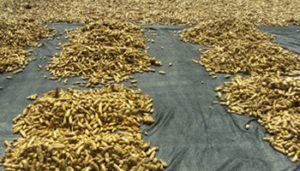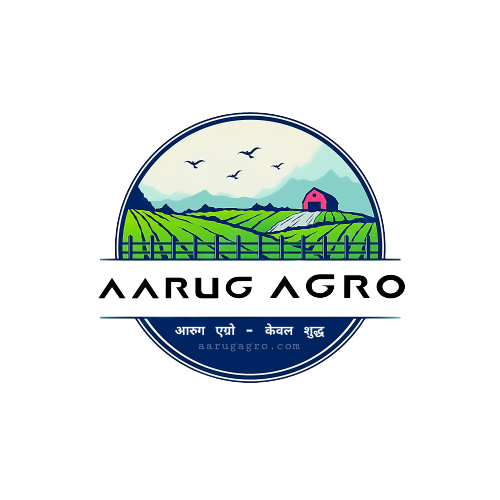Turmeric/Curcuma Farming Guide: We will discuss today the Turmeric Farming Techniques and Planting Methods of turmeric. Due to its many uses and benefits, turmeric is becoming very popular in India. In addition to this, it is in high demand in both domestic and international markets. Your home garden can grow turmeric in pots, containers, or backyards.

We will discuss these topics in this article :
Turmeric plantation
Aarug’s Turmeric Growing Conditions
Turmeric Plantation Soil
Planting Turmeric on Prepared Land
The Best Time to Plant Turmeric
Turmeric crop plant material
Turmeric Crop Irrigation Requirements
Turmeric Crop Rotation
Turmeric Plant Care, Pests, and Diseases
Turmeric Harvesting Techniques
Turmeric Fingers: Curing, boiling, and drying
Turmeric seed preservation
Turmeric yields
Turmeric plantation: It is recommended to select well-developed, healthy, and disease-free rhizomes for planting. A hand hoe is used to dig small pits in the beds positioned 25 cm apart and covered with dry powdered cattle manure or soil. The optimal furrow and ridge spacing is 45-60 centimeters between rows and 25 centimeters between plants. Turmeric rhizomes should be planted at a rate of 2,500 kg per hectare.Aarug’s Turmeric Growing Conditions: As a tropical herb, turmeric grows both in tropical and subtropical climates. Shade or open ground exposed to the sun will produce luxuriant growth, but the canopy will produce larger and better rhizomes. The climatic conditions must be humid for turmeric to grow.
Turmeric Plantation Soil : A rich, friable soil is ideal for Turmeric cultivation. It is best to plant in soils that have a little more sand in them (loams and sandy loams). There are a variety of soil types where it can be grown, including light black, sandy loam, and red soils, as well as clay loams. Rainfed areas will find it growing on light black soils, ashy loams, and stiff loams.
Planting Turmeric on Prepared Land : A minimum tillage operation may be used when preparing land for turmeric farming. A minimum of 50 cm spacing should be provided between beds that measure 15 cm high, one meter wide, and a convenient length. A shallow pit is dug on top of each ridge of the irrigated crop so the rhizomes can be planted. Spacing generally adopted is 45-60 cm betwIt is generally recommended to space plants 15-20 cm apart and ridges 45-60 cm apart.ckingIt is beneficial to solarise beds to prevent the multiplication of pests and diseasesion should be kept awaAfter soil solarisation is finished, polythene sheets should be stored safely
The Best Time to Plant Turmeric : There is a difference in planting season depending on the region and variety of the crop. The planting process occurs during May-June or July-August on different tracts. Rice, sugarcane, finger millet, and rice can be rotated with turmeric. Onions, Brinjal, and Tomatoes are usually grown in mixed stands along with Onions, Maize, and Finger millets.
Turmeric crop plant material : Planting season varies by region and crop variety. Different tracts are planted during May-June or July-August. Rice, sugarcane, finger millet, and rice can be rotated with turmeric. Onions, Brinjal, and Tomatoes are usually grown in mixed stands along with Onions, Maize, and Finger millets.

Turmeric Crop Irrigation Requirements : It depends on the soil conditions and the climate as to how many irrigations turmeric needs. When medium heavy soils are irrigated, 15-25 irrigations are given, and when light textured red soils are irrigated, 35-40 irrigations are required.
Turmeric Crop Rotation : In addition to turmeric, sugar cane, chili, onions, garlic, elephant foot yam, pulses, wheat, and ragi are also grown in rotation. Often grown with ginger in some areas and with chillies and quick-growing vegetables in others.
Turmeric Plant Care, Pests, and Diseases :
- It is possible to cut open shoots with shoot borer incidences, remove the larve and destroy them if they are found. A spray of 0.5% neem oil may be applied fortnightly if necessary.
- Turmeric does not seem to be affected by any major diseases. The use of Bordeaux mixture 1% can be restricted to control leaf spot and leaf blotch. Rhizome rot can be prevented by applying Trichoderma at the time of planting.
Turmeric Harvesting Techniques :

January through April are the most common months for harvesting. In 7-8 months, early varieties mature, and in 8-9 months, medium varieties. When the leaves start drying up and turning yellow, the crop is ready to harvest. Rhizomes are collected by hand-picking or by carefully lifting clumps with a spade at maturity, after a thorough plowing of the land. Collecting and cleaning the picked rhizomes is the next step. Curing is carried out by separating the finger and mother rhizomes.
Turmeric Fingers: Curing, boiling, and drying :

A fresh rhizome is boiled in water and then dried in the sun. By boiling, the viability of fresh rhizomes is destroyed and raw odor is removed, drying time is reduced, starch is gelatinized for hardening, and color is more uniform and evenly distributed in the rhizome. Traditionally, the cleaned rhizomes were immersed in water just enough to soak and then boiled in copper, iron, or earthen vessels. After boiling them for a while, they should become soft. After the rhizomes are properly cooked, the froth will come out and white fumes will appear. When pressed between fingers, the rhizomes will be soft and yield. After the rhizomes reach a soft state, they are boiled for 45 to 60 minutes. Undercooking causes the dried product to become brittle while overcooking spoils the color.
Turmeric seed preservation :

Turmeric seed preservation: It is generally a good practice to heap rhizomes under trees or under well-ventilated sheds and cover them with turmeric leaves. A mixture of earth and cow dung is sometimes plastered over the heap. A pit filled with sawdust can also be used to store seed rhizomes. Wooden planks can be installed over the pits to provide aeration.Turmeric yields :

A pure crop yields between 8,000 and 10,000 kilograms per acre. Exceptionally favorable conditions, e.g. generous manuring and copious irrigation can result in 12,000 kg per acre.
BENEFITS OF TURMERIC AND CURCUMIN: The Indian market is one of the largest exporters of turmeric powder and turmeric fingers. Due to its high curcumin content, turmeric helps build a good amount of antibiotics. Curcumin in turmeric reduces the risk of heart disease, cancer, metabolic syndrome (stroke or heart disease) and various degenerative conditions.
A household should use turmeric daily for the following 10 proven benefits and natural remedies:
Manages weight loss : Among the spices with anti-inflammatory properties, turmeric is one of the most popular. Turmeric tea should be included in our daily diets. It promotes weight loss and digestive health. Blood sugar problems are also managed by it.
Boosts heart health: High cholesterol issues and blood pressure can be controlled with turmeric curcumin. Controlling cholesterol and keeping the heart healthy are two of its benefits. Blockages in the heart are reduced by it.
Immune system is strengthened : Medically proven superpower spices include turmeric. In addition to building immunity, it reduces the risk of viral infections. Corona-virus symptoms can also be reduced with turmeric.
Reduces the signs of aging : The use of turmeric powder for beauty treatments is also well known. Reduces sunblock’s skin problems and anti-ageing problems. Turmeric extract is used in many cosmetics products.
Anti-cancer properties: Taking turmeric curcumin anti-cancer treatment can help you recover from cancer. Most cancers are skin cancers, stomach cancers, and breast cancers. Curcumin helps to kill cancer-fighting bacteria and reduce the level of infection due to its high curcumin content.
Pain caused by arthritis can be relieved by turmeric finger : It is effective in reducing arthritis pain when applied to the finger and powder of turmeric. Due to its anti-inflammatory properties, it reduces pain and swelling. It contains 95% curcumin.
Reduces scarring : The FDA has approved turmeric powder for its many health benefits. Scars from burns, accidents, and infections can be healed with it.
Reducing depression is one of its benefits :Turmeric has been reported to help reduce depression in scientific studies. Most doctors recommend consumption of at least 12.5 to 1.5 teaspoons per day. Stress is reduced and happy hormones are boosted.
Reduces blood sugar levels : Many people suffer from hypertension or blood sugar diseases because of a busy lifestyle and a poor diet. Brain disease and cardiac arrest are also associated with it.


